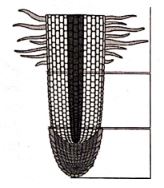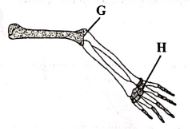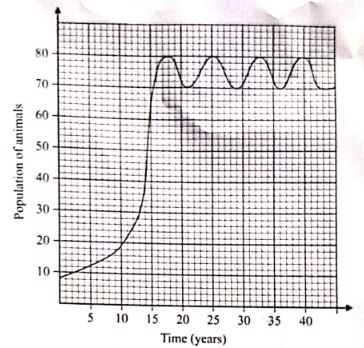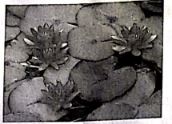QUESTIONS;
Answer all the questions in the spaces provided.
- State two reasons why humans are not commonly used as specimens for genetic studies.(2marks)
- On the diagram of the root tip below, label the regions where:
- cells become specialised as E(1 mark)
- cells increase in size as F(1 mark)
-
- State two environmental conditions that can lead to the formation of carboxyhaemoglobin in the human body. (2 marks)
- Explain the effect of carboxyhaemoglobin in the human body. (2 marks)
- State the significance of each of the following characteristics of the mammalian lungs:
- being elastic
- having pleural fluid.
- Below is a diagram of a bacterium.
- Identify the Kingdom to which the organism belongs. (I mark)
- State two features shown on the diagram that are characteristics of this Kingdom. (2 marks)
-
- Name the part of the ovule that forms each of the following structures after fertilisation:
- zygote (1 mark)
- testa. (1 mark)
- Name the hormone responsible for the development of a deep voice in humans. (I mark)
- Name the part of the ovule that forms each of the following structures after fertilisation:
-
- Differentiate between a population and a community as used in ecology. (I mark)
- Explain one negative effect of the use of herbicides on human health. (1 mark)
- State two ways through which energy is lost from one trophic level to the next in a food chain. (2 marks)
- The following apparatus is used in biological studies.
- Identify the apparatus. (I mark)
- State its function. (1 mark)
-
- Give two reasons why anaerobic respiration yields less energy than aerobic respiration. (2 marks)
- Explain why fats are not efficient respiratory substrates. (2 marks)
- The table below shows the concentration in parts per million of sodium and iodide ions in sea water and cell sap of a plant.
Sodium ions concentration Iodide ions concentration Sea water 326 39 Cell sap 162 574 -
- Which of the two ions intake will be affected if the plant was sprayed with a chemical that inhibits respiration. (1 mark)
- explain your answer in 10(a)(i). (2marks)
- An experiment was set up as shown in the diagram below.
At the end of the experiment it was observed that the starch turned blue black while the colour of iodine solution in the beaker did not change. Account for this observation. (2 marks)
-
- The diagram below represents a stage in cell division.
- Name the stage of cell division illustrated. (1 mark)
- Give a reason for your answer in 11(a)(i). (1 mark)
- In the space below, illustrate the next stage of cell division after the one illustrated above.
- Explain the disadvantage of in-breeding among living organisms. (2 marks)
- Explain why protozoans do not require an elaborate system of gaseous exchange. (2 marks)
- The diameter of the field of view of a light microscope was found to be 1.5 mm. Cells observed under the field of view appeared as shown below
.
Determine the length of each cell in micrometers. (1 mm 1000 μm) (2 marks) - Name the cell organelle responsible for each of the following activities:
- protein synthesis (1 mark)
- transport of lipids (1 mark)
- Name two organisms that belong to the Kingdom Protoctista. (2 marks)
-
- Explain why only the fine adjustment knob should be used when focusing a specimen using the high power objective lens of the light microscope. (2marks)
- An animal cell was viewed under a light microscope using objective lens of *75 and eye piece lens of ×10. Determine the total magnification of the image. (2 marks)
- A goat and a sheep are both herbivores. Explain why the two can comfortably exist in the same ecosystem. (2 marks)
- The diagram below shows the bones of the human arm.
- Name the type of joint formed in the region labelled;
- G (1 mark)
- H (1 mark)
- Explain why the bones of the cranium are fused. (1 mark)
- Name the type of joint formed in the region labelled;
- 60 white and 60 black mice were released in an area inhabited by jackals. After six weeks, it was established that 24 black and 8 white mice had remained.
- Account for the above observation. (3 marks)
- Name the evolution theory that supports this observation. (1 mark)
- A small amount of a substance K was applied on one side of bean coleoptiles. After 36 hours, the coleoptiles curved away from the side where the substance was applied.
- Suggest the likely identity of substance K. (1 mark)
- Explain how the substance may have caused coleoptiles to curve. (3 marks)
- Explain the role of antidiuretic hormone when the human blood water level is below normal. (3 marks)
- Equal amounts of crushed irish potato were placed in equal volumes of hydrogen peroxide solution at various pH values. A gas, L, was produced, its volume measured and recorded as shown in the table below.
PH 4.2 7.0 9.2 Volume of gas L (cm3) 2.9 5.9 7.9 - Identify gas L. (1 mark)
- Account for the difference in the volume of gas L produced at pH values 4.2 and 9.2. (3 marks)
-
- Name the causative agent of Trichomoniasis. (1 mark)
- State the role of hair-like structures in each of the following: (2 marks)
- fallopian tube
- nasal lining.
- Name the agent of pollination in a maize plant. (1 mark)
- Below is a graphical representation of the population of animals in a certain ecosystem over a period of time.
- Determine the carrying capacity of the ecosystem. (1 mark)
- Account for the change in population for the first 15 years. (3 marks)
- The photograph below shows a plant obtained from a certain habitat.
- Suggest the likely habitat for the plant. (1 mark)
- Explain your answer in 25(a). (3 marks)
MARKING SCHEME
-
- Humans take longer to grow/ mature (for observations/ inferences to be made);
- Not convenient/cannot be caged/ contained (under some set experimental conditions);
- It is unethical; OWTTE
-
-
-
- Burning of carbon in inadequate supply of air/oxygen; s:/k
- (Excessive) supply/emission of carbon (II) oxide (exhaust fumes/burning jiko):
- Carboxyhaemoglobin is a stable compound/ does not dissociate/break; haemoglobin is not free/released to transport the oxygen; resulting in suffocation/ death;
-
-
- To accommodate varied volumes of air/respiratory gases (during the breathing process);
- Shock absorber/ shield the (delicate) lungs against mechanical damage/friction (with ribs/ adjacent bones);
-
- Monera:
-
- No membrane-bound organelles/fewer organelles;
- No definite nucleus/prokaryotic/primitive nucleus;
- Presence of flagella;
- Unicellular;
-
-
- Egg cell;
- Integuments;
- Testosterone;
-
-
- A population is a group of organisms of the same species co-existing/living together in a particular habitat while a community is a group of plant and animal/different species living together in a given habitat;
- Herbicides (gradually) accumulate in food chains (plant/ animal tissues) which when fed on by human beings slowly accumulate in human tissues (when inhaled/come in contact with the body) causes diseases/poisoning/ affecting the working of some body organs/systems/some are carcinogenic/cause death;
-
- Elimination of wastes/excretion/defeacation/urination:
- Decomposition of organic matter/unconsumed parts of organisms;
- Through respiration;
-
- (A pair of) forceps;
- Picking up/holding specimens;
-
-
- Incomplete/partial breakdown/ oxidation of substrates;
- Inadequate/shortage of oxygen;
-
- Fats are insoluble in water hence not easily transported to body tissues;
- Fats require more oxygen to be oxidized;
-
-
-
- Iodide ion (I');
- The uptake of I is done by active transport; which is respiration/energy-dependent which when inhibited consequently affects/impairs the active transport process which is responsible for the uptake of the ions;
- The visking tubing being semi-permeable; allowed selective passage of the iodine molecules into it; which react with starch to form a blue-black colour/ starch molecules are bigger than iodine-could not pass out through the pores into the beaker;
-
-
-
- Metaphase I;
- Spindles have formed/ bivalent pair of chromosomes aligned at the equator/homologous chromosomes align at the equator;
-
- (Inbreeding) hampers variation; resulting in the propagation of undesired genes (some of which might be weaker/ lethal), to subsequent generations;
-
- They have a large surface area to volume ratio; diffusion (across its cell membrane) is sufficient for its gaseous exchange needs;
- Number of cells in the field of view = 6
Diameter of field of view = 1.5 mm;
Size of each cell (in the field of view) − (1.5/6 x1000) um
= 250um; -
- Ribosomes;
- Golgi bodies/apparatus/smooth endoplasmic reticulum;
-
- Amoeba;
- Paramecium/Paramecia;
- Trypanosoma;
- Spirogyra;
- Euglena;
- Chlamydomonas;
-
- The distance/ space for manipulation on the stage is limited; to avoid crushing the slide/ specimen;
- Total magnification = Eye piece lens x objective lens power;
=10 × 75
=x750;
- A goat is a browser (mainly feeds on shrubs/leaves) while a sheep is a grazer, (mainly feeding on grass); there is no competition for (the critical common resource) food needed for their survival;
-
-
- Joint G- Hinge joint;
- Joint H- Gliding/sliding joint;
- (To form firm strong joints so as) to protect the (delicate) brain enclosed therein;
-
-
- There was a greater decline in the number of white mice compared to the black ones; the white mice were selected against (by nature); they did not camouflage (well) with the surroundings because of their bright white colour/ could easily be seen by the jackals/predators unlike the black mice;
- (Charles Darwin's theory of) natural selection;
-
- Auxins/Indole-Acetic Acid;
- The substance caused faster division/elongation of cells on the side it was applied; giving rise to faster growth compared to the opposite side; resulting in a curvature/ bending away from the side where it was applied;
- (When the blood water level is below normal), the body is dehydrated; more antidiuretic hormone (ADH) is secreted the antidiuretic hormone stimulates the kidney tubules (distal convoluted tubule/ collecting ducts); increasing their permeability to water, water is reabsorbed into the bloodstream until the osmotic balance is attained;
-
- Oxygen;
- More gas was produced at pH 9.2 (higher pH); this basic/ alkaline pH; was favourable for the optimal working of the enzyme (catalase) in the irish potatoes; lower pH/acidic medium (4.2) did not favour the optimal working of the enzyme;
-
- Trichomonas vaginalis:
- Propel the ovum/zygote/sperm into the oviduct/ fallopian tube;
- Trap solid/dust particles in the inhaled air;
- Wind;
- Trichomonas vaginalis:
-
- 75+ 1;
- The population increased exponentially; because the organisms had adjusted to the environment; conditions were favourable (for reproduction/breeding); there was adequate food/water/ space/no competition (for resources); there were no diseases; more reproduced/ fewer deaths;
-
- Aquatic/fresh water/swampy/marshy environment;
- Broader leaf surfaces; to increase the surface area for the loss of excess water; the broad surfaces have more stomata on the upper leaf surfaces to enhance loss of excess water; presence of shallow roots to minimize absorption of water; flowers raised above the water surface to enhance pollination; broad leaf surfaces for buoyancy;
Join our whatsapp group for latest updates
Tap Here to Download for 50/-
Get on WhatsApp for 50/-
Download BIOLOGY Paper 1 Questions and Answers - KCSE 2022 Past Papers.
Tap Here to Download for 50/-
Get on WhatsApp for 50/-
Why download?
- ✔ To read offline at any time.
- ✔ To Print at your convenience
- ✔ Share Easily with Friends / Students










